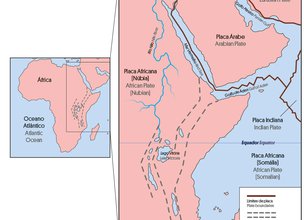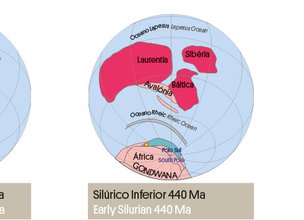More than 540 million years ago, the territory we now walk on was close to the southern hemisphere, at the current latitude of Buenos Aires. From a process similar to what can be observed today in the African East with the formation of the intracontinental rift and the emergence of the Great Lakes, about 500 million years ago, formation and extension would have taken place from the primitive ocean - the Rheic - between the continent Gondwana and the microcontinent Avalonia. In this process of oceanization, sands of margin were deposited first, which still register the typical waves of the marine current, the laminations or traces of the biological activity of trilobites and arenicolas, and then the muds, indicators of greater depth.
From the lower Devonian to the lower Carbonic (390-370 Ma), the Rheic ocean shortened until it extinguishes during the continental collision between Laurentia, Avalonia and Gondwana.
As a result of the continental collision, the shortening of materials and the heat generated by the stresses and volumes of magma generated, the Rheic sediments dehydrated, hardened, bent and in some cases were transported several kilometers from the initial location, processes that ocurred more than 5 km deep forming schists and metaconglomerates, and quartzites.
More than 540 million years ago, the territory we now walk on was close to the southern hemisphere, at the current latitude of Buenos Aires. From a process similar to what can be observed today in the African East with the formation of the intracontinental rift and the emergence of the Great Lakes, about 500 million years ago, formation and extension would have taken place from the primitive ocean - the Rheic - between the continent Gondwana and the microcontinent Avalonia. In this process of oceanization, sands of margin were deposited first, which still register the typical waves of the marine current, the laminations or traces of the biological activity of trilobites and arenicolas, and then the muds, indicators of greater depth.
From the lower Devonian to the lower Carbonic (390-370 Ma), the Rheic ocean shortened until it extinguishes during the continental collision between Laurentia, Avalonia and Gondwana.
As a result of the continental collision, the shortening of materials and the heat generated by the stresses and volumes of magma generated, the Rheic sediments dehydrated, hardened, bent and in some cases were transported several kilometers from the initial location, processes that ocurred more than 5 km deep forming schists and metaconglomerates, and quartzites.

Continental plates collision

Movement of continental plates between 500 and 350 million years ago
Location
Praia Norte
Coordinates
Lat: 41.6969394
Long: -8.8508353
Hello little one!
I'm Piquinhos and I can help you learn more about the Geopark!
Technical details
A 400 MILLION-YEAR-OLD ROCK OCEAN
The Iberian Peninsula is part of the internal range of the Varisca Chain that extends for more than 3000 km, from Morocco to the north of Bohemia. It resulted from the approach and collision (starting in the Middle Devonic) of the NO portion of Gondwana (current African territory) and Laurentia - Baltica, separated by Tethis, and whose closing position corresponds to the suture zone marked by the Porto-Tomar shear. The survey of the Varisca Chain took more than 70 Ma, having a polyphasic and zonal character depending on the characteristics of the approximation vector of the two supercontinents involved in the structures of the Iberian Massif, allowing the definition of several geotectonic zones based on the different paleogeographic, tectonic characteristics, metamorphic and magmatic evidenced for each sector(Matte & Ribeiro, 1975; Dias & Ribeiro, 1995). Tectogenesis was accompanied by regional metamorphism and magmatism, which mainly affected internal areas.
References:
Carvalhido, R. (2012). O Litoral Norte de Portugal (Minho-Neiva): evolução paleoambiental quaternária e proposta de conservação do património geomorfológico. Universidade do Minho.
Matte, P. & Ribeiro, A. (1975). Forme et orientation de l'ellipsoïde de déformation dans la virgation hercyenne de Galice. Relations avec le plissement et hypothèses sur la genèse de l'árc ibéro-armoricain. C. R. Acad. Sc. Paris, 280.
Dias, R. & Ribeiro, A. (1995). The Ibero-Armorican Arc: A collision effect against an irregular continent? Tectonophysics, 246,113-128.
References and scientific articles
Carvalhido, R. (2012). O Litoral Norte de Portugal (Minho-Neiva): evolução paleoambiental quaternária e proposta de conservação do património geomorfológico. Universidade do Minho.
Matte, P. & Ribeiro, A. (1975). Forme et orientation de l'ellipsoïde de déformation dans la virgation hercyenne de Galice. Relations avec le plissement et hypothèses sur la genèse de l'árc ibéro-armoricain. C. R. Acad. Sc. Paris, 280.
Dias, R. & Ribeiro, A. (1995). The Ibero-Armorican Arc: A collision effect against an irregular continent? Tectonophysics, 246,113-128.
Continental plates collision
Movement of continental plates between 500 and 350 million years ago
Child Mode
Discover the geopark in a simpler format, aimed at the little ones.
Clique ENTER para pesquisar ou ESC para sair